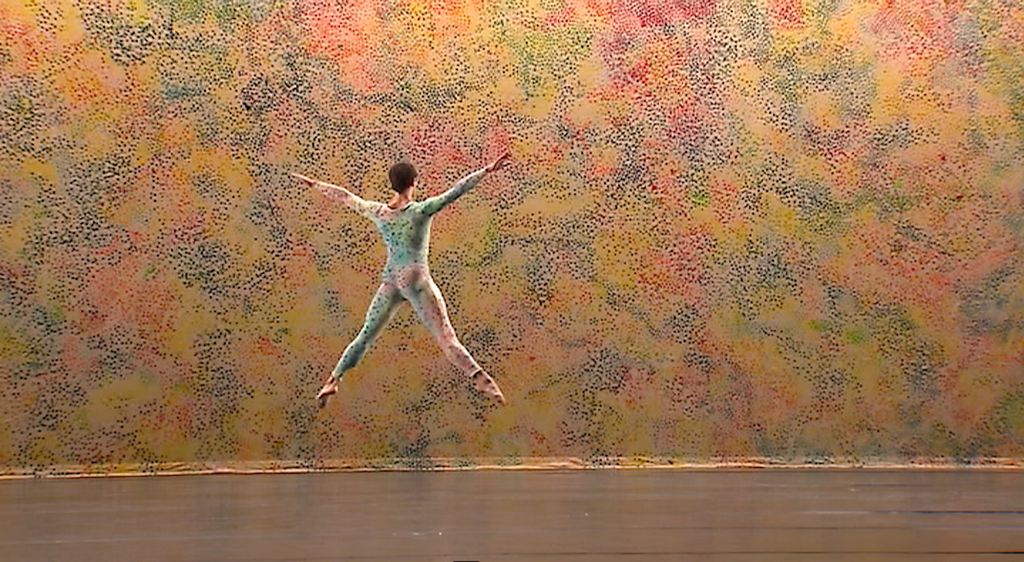What’s going on in his 1958 dance “Summerspace”? Nothing but life.
Aug. 15, 2019
Three women enter the “Summerspace” stage in sweeping arcs, like birds on the wing, each in a different meter. Now they stop, making a group, as if perching on a branch. When a man enters, he’s of a different feather, advancing on a straight diagonal path in a different rhythm; and he pauses, only to reverse direction and pause again.
This is the start of Merce Cunningham’s “Summerspace” (1958), a dance that, when new, seemed such a nonevent that it was ignored outside the Cunningham company. Yet its quiet idyll cast a spell. “Summerspace” became one of Cunningham’s most celebrated, even classic, dances. This year in New York, it has been danced by Ballet West in April at the Joyce and will be revived by New York City Ballet in October. (These excerpts come from a 2008 film, directed by Charles Atlas.)
Nothing’s happening here, is it? Nothing but the world outside the human one. Four women, taking different routes, arrive one after another in a single diagonal line, all facing the same way.
No sooner do they settle there, though, than they all turn and take off in the opposite direction at greater speed. Something has alarmed the flock. As often in Cunningham, we see pure dance that evokes the ways of nature and wildlife.
Cunningham hadn’t set out to evoke nature. When first conceiving “Summerspace,” even before titling it, he began to imagine a dance in the round. He proceeded by studying the different trajectories dancers might make from the six various wings, three on either side of the stage.
Watch the web of separate flight paths in this ensemble: It’s an ideal example of how dancers coexist on the “Summerspace” stage. All are purposeful soloists with their own routes and speeds.
It was already a law of Cunningham dance theater that music, designs and choreography were all prepared apart from one another, meeting only at the dress rehearsal or first night. In this case, the designer was Robert Rauschenberg (who had been the Cunningham company’s chief designer since 1954); the composer was Morton Feldman; they and Cunningham prepared their contribution in different states of the Union. Feldman called his score “Ixion.” It has its rhythms, which are different from the dance’s, as the solo (danced here by Holley Farmer)shows.

Cunningham usually just gave his artistic colleagues the title he had chosen for the piece; he told the composer its duration, the designer how many dancers and which ones, and sometimes he gave them one or two more ideas. In this case, he wrote to Rauschenberg that his spatial ideas had led him to envisage the dance onstage as part of a larger continuity, as if the dancing carried on in like manner out of sight. As his plans evolved, Cunningham began to see its rhythms as those of summer. Hence the name “Summerspace,” which is surely a pun: both “summer space” and “summer’s pace.”
This information was enough for Rauschenberg, who was inspired to evoke the landscapes of Impressionist and Pointillist painting. In a marvelous stroke, he conceived speckled costumes that wholly matched the décor, so that the dancers became completely at one with their environment, fauna merging into their scenery.


Cunningham’s music and design colleagues were not subordinate to him, nor he to them; and each dancer was a soloist, with her or his own command of space and time. Cunningham determined many of the “Summerspace” details — how many dancers for each section, which route they took, what kind of speed, whether they moved together or separately — by chance operations. Now in his late 30s, Cunningham had been using coins, dice or the I Ching as compositional methods since earlier in the 1950s — he employed them in private, before beginning rehearsals — but he asked chance to answer different questions for each work.
And many things he did not leave to chance. Carolyn Brown, his lead female dancer and frequent partner, was having problems with turns at the time. (In her memoir, she calls them her “bête noire.”) Cunningham deliberately inserted many kinds of turns into “Summerspace” as a useful challenge for her. (Cheryl Therrien dances the solo here.)
Always determining a different movement idiom for each dance, he chose here one with a high degree of ballet vocabulary — the stretched lines, the fluency in traveling speed and turns — while often employing rhythms and coordinations that were far from ballet. (Ashley Chen dances the lead man, originally Cunningham’s role.)
One brief duet, though it has no contact between man and woman nonetheless shows a powerful tension just because the man immediately adopts the same vocabulary as woman; and, once, he sharply changes direction to keep her in his view. (The dancers here are Mr. Chen and Derry Swan.)
As when watching birds in a garden, the more you look, the more hints of character and narrative you find here. The “Summerspace” lead man behaves as if this is the mating season; the joke is that all the women are wary of him, whereas they’re more interested in the second man, who only occasionally — but always successfully — pays attention to them.
Yet “Summerspace” has nothing of a garden’s sense of confinement. Serenely and purposefully, its dancers come and go as if passing across wide stretches of scenery visited by no human being.
